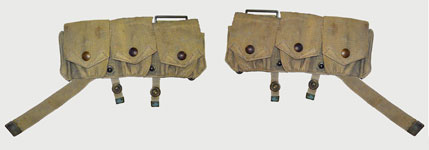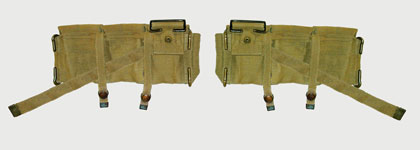Web Equipment Pattern 1908 - Territorial Force Variants
Equipment Carriers
Karkee Web have been able to locate actual surviving examples of almost none of the equipment we are trying to illustrate here. At the same time, we feel it it important to provide the best documentation we can for this important part of the history of British Web Equipment.
Carrier, cartridge, 45 rounds, left and right (C.L., T.F. Pattern)


 With Mills able to programme their looms, it was easy to manufacture almost any configuration, both externally and internally. The existing requirement, even up to 1914, was for the T.F. to carry 100 rounds. The form Lethern illustrates had three in-line pockets and these are tapered. They must therefore have been internally divided for 5 round chargers, the Carrier simply being the lower tier of a Patt. ’08 Cartridge Carrier. They were made “handed”, by virtue of the Diagonal Strap, but no extension strap was fitted behind the Carrier. The absence of this Tab is shown well here, at far left, as the Carriers for bottle and Sirhind Head have to be on the same Brace ends. The Carriers at near left from Pete Crosby Collection. Photograph © Peter Crosby.
With Mills able to programme their looms, it was easy to manufacture almost any configuration, both externally and internally. The existing requirement, even up to 1914, was for the T.F. to carry 100 rounds. The form Lethern illustrates had three in-line pockets and these are tapered. They must therefore have been internally divided for 5 round chargers, the Carrier simply being the lower tier of a Patt. ’08 Cartridge Carrier. They were made “handed”, by virtue of the Diagonal Strap, but no extension strap was fitted behind the Carrier. The absence of this Tab is shown well here, at far left, as the Carriers for bottle and Sirhind Head have to be on the same Brace ends. The Carriers at near left from Pete Crosby Collection. Photograph © Peter Crosby.

Speculative Carrier, cartridge, 45 rounds, left and right (N.C.L., T.F. Pattern)
Mills seemed implicitly to adhere to the principle. “The customer is always right.” They therefore developed several variations of the five pocket ’08 Carrier. In 1910, Canada adopted Patt. ’08, but with Cartridge Carriers at left, for ammunition in packets of ten rounds. The top pocket was for one packet and five loose rounds, held in integrally woven loops on the front wall. Although it was wide, this was only to allow a press stud on either side of the vertically disposed ten round packet.
Since a tapered pocket T.F. Carrier is known, it is speculated that there might have been a triple “box pocket” variant. Each pocket could then contain one packet and five loose rounds, so still 45 rounds per Carrier. If such a variant existed, its parallel sides should give it away, plus the vertical weaving marks on the front face, showing where threads have been “shed” to form the internal loops. No example has been seen, nor has any photograph surfaced.
Pocket, cartridge, 15 rounds
The Equipment Regulations for T.F. units used largely generic nomenclatures. The ammunition requirement was to be with “…pouches, or bandoliers holding 100 rounds…”. With the T.F. Pattern, the extra 10 rounds could be carried in the Haversack. However, M.E.Co. could also supply single 15 round Pockets, which could be threaded on the Braces, bringing the total up to 120 rounds. It is not known if versions for charger-loaded, or packeted rounds were made.
The probable external appearance is well-shown in the New Zealand Patt. ’13 W.E Cartridge Pocket, for wear on a 21/4 inch belt.
The only change required would be to re-orientate the belt loops to be horizontal and stitched to be a tighter fit on the 2 inch Braces. This Pocket took a 10 round packet, with five loose rounds in integrally woven loops. From the Collection of Barry O’Sullivan. Photographs © Barry O’Sullivan.Carrier, great coat, Indian patt. (1st Issue)
The above nomenclature is taken from the 1920 edition of the Price List of Emergency Pattern Stores. With the Cartridge Carriers reduced in size by 40% and in its exterior fittings, the 1910 price of 4s 11d would have correspondingly been less. This left the Pack which, at 4s 6d was the next most expensive. For decades, the Army had carried its Great Coats rolled, or folded in various combinations of straps and exposed to the elements. Mills simply stripped the Pack down to the essential binding elements necessary to make a bundle.
It comprised two vertically aligned straps, with a third horizontal strap. A piece of 2 inch webbing, its ends folded at 90 degrees formed the skeleton equivalent of the 2 inch tabs on the Pack. A short 1 inch strap was stitched low-down and fitted with 1 inch buckles. These straps all acted as distance pieces, ensuring a secure and integral framework, in which the folded Great Coat could be carried. The Cover, mess tin, D.S., rotated 90 degrees, was threaded on the vertical straps. Lethern illustrates a 1st Issue Carrier, with plain, crimped Tips on all the straps.
Carrier, great coat, Indian patt. (2nd Issue)
In 1909, eyeleted Tips were substituted for the original plain, crimped versions. Photographs show the Carrier being worn by Territorial troops during the campaigns in Mesopotamia and it became the standard for Patt. ’08 W.E. used by Indian Army troops, hence the nomenclature above is from a Section A1 listing. A 1922 example, made by M.E.Co. is illustrated, though the initials N.R.P. have not yet been translated. From the collection of Rog Dennis, Photo © Rog Dennis 2009.
The drawing of a 2nd Issue “Coat Carrier”, by Lethern himself, is dated May 20 1911. That is an American format, but M.E.Co.’s office rubber stamps would have been originally sourced in the U.S.A., when the Company was still American.
Carrier, water bottle (T.F. pattern)
Early supplies of Carrier for the Army were un-necessarily complicated by having the novel feature of being attachable to the Haversack, when this was worn on the back in Battle Order. The Carrier was therefore shorn of its vertical tab strap and female press fastener half, leaving just the “V” strap over the bottle shoulders. Note that the photographs are a c.g.i. from a 1st Issue standard Carrier. By November 1909, a modified Carrier had been approved for standard Patt. ’08. This changed the “V” strap to a single, diagonal strap. It is a reasonable supposition that T.F. versions of this was also offered by M.E.Co., however, no examples of any T.F. Carrier have been seen!
Frog, without tab (T.F. pattern)
Entrenching tools were not at first scaled for the T.A., so the tab for attaching the Carrier, intrenching tool, helve was not required. Although this Frog was designed for the Patt 1907 Bayonet, which fitted the S.M.L.E., the T.A. ‘s Long Lee Enfield used the Pattern 1888 Bayonet, whose scabbard locket was easily accommodated in this Frog. When E.T.’s were made obsolete in 1923, the tabs were removed for salvage, but this MECo example, dated 1913, shows no sign of having had a tab. From John Thorne Collection. Photo © J. Thorne 2009.